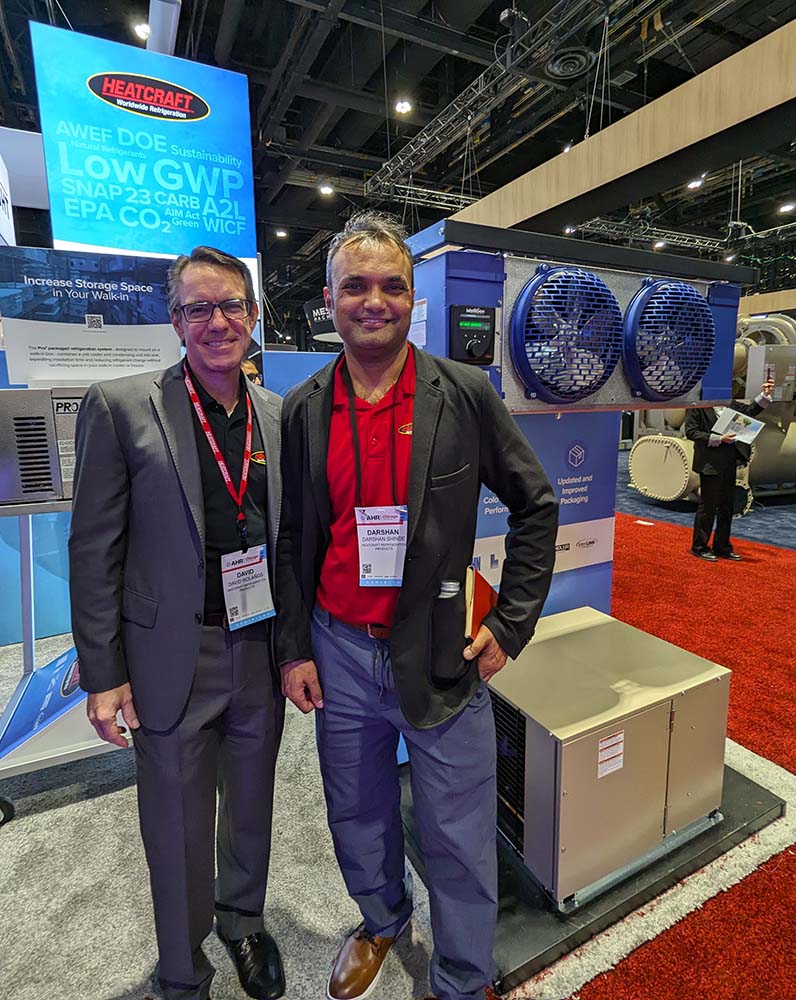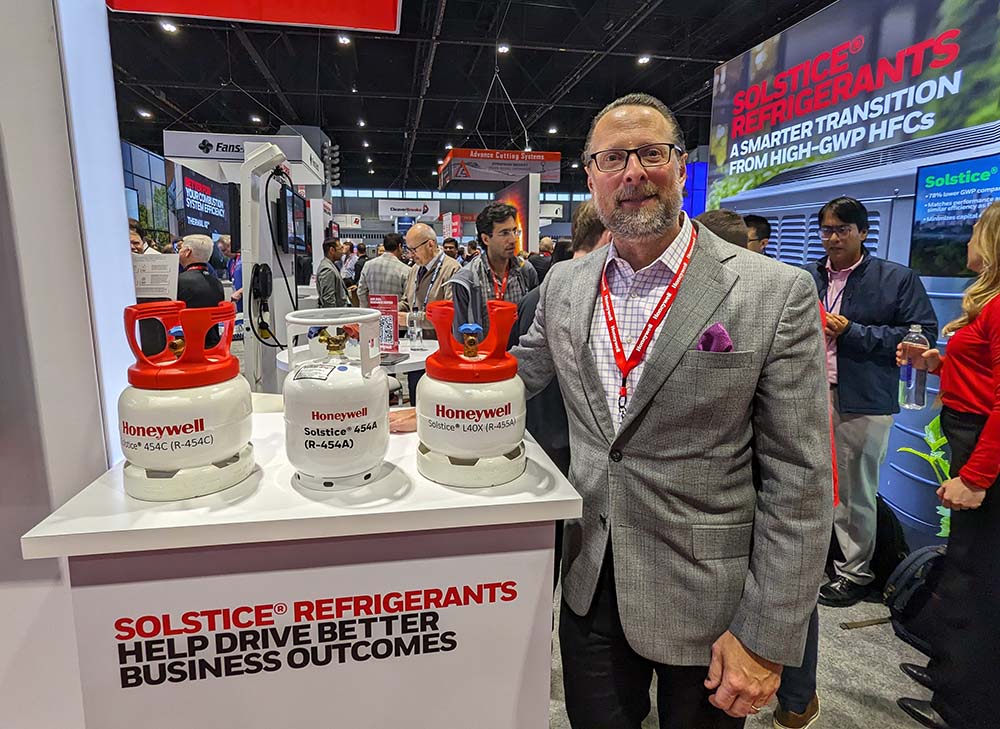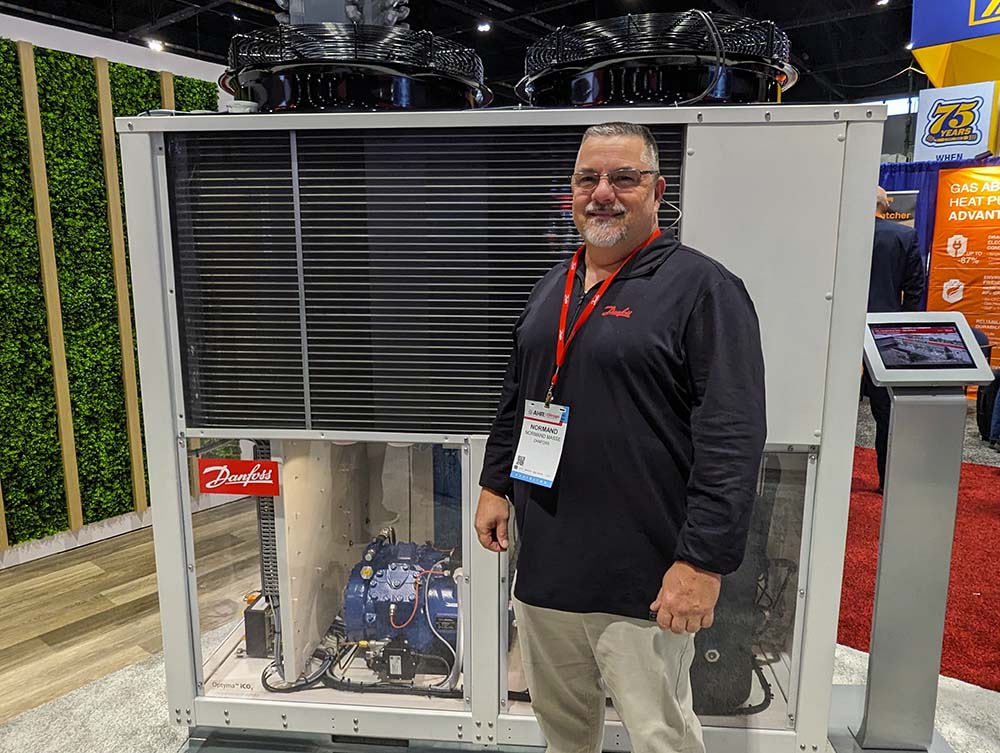As mandated by the AIM Act, the commercial refrigeration sector is transitioning away from high-GWP refrigerants such as R-404A and R-134a, in favor of low-GWP options like CO2 (R-744) and propane (R-290). Additionally, mildly flammable (A2L) refrigerants will become available pending final approval of the Environmental Protection Agency's (EPA’s) Significant New Alternatives Policy (SNAP) Rule 26. As a result, most new commercial refrigeration systems used in supermarkets and convenience stores will be required to utilize refrigerants with a GWP limit of either 150 or 300, with compliance deadlines that vary depending on the size of the equipment.
During the AHR Expo, manufacturers discussed their preparations for the transition to low-GWP refrigerants and showcased their commercial refrigeration technologies that contractors can expect to see in the near future.
director of solutions strategy
Copeland
Significant Impacts
The latest step in the HFC phasedown, which involved an additional 30% reduction in HFC production that went into effect on January 1, 2024 (on top of the 10% reduction in 2022), is a key industry milestone that will have significant impacts, said Andre Patenaude, director of solutions strategy at Copeland.

LOWER GWP: Joe Summers describes some of the lower-GWP solutions offered by Copeland. (Staff photo)
“As HFC production cuts reduce the supply of legacy refrigerants, the demand for lower- GWP alternatives will continue to grow,” he said. “Reduced HFC supplies could lead to shortages and a subsequent increase in legacy refrigerant prices, while placing increased emphasis on the importance of proper HFC recovery and reclamation.”
The EPA's Technology Transitions rule also sets GWP limits of 150 to 300 for new equipment, with compliance dates ranging from 2025 to 2027 across various food retail refrigeration products. This will compel retailers and contractors to assess whether to repair or replace outdated HFC-based equipment, said Patenaude. If replacement is in the cards, manufacturers have it covered, as they are busy designing and developing the next generation of equipment in order to meet these rapidly approaching deadlines.
“Copeland has prepared for this industry-wide equipment migration by optimizing compressors, condensing units, electronic controls, leak detection, and associated components for use with lower-GWP CO2, A3, and A2L alternatives,” he said. “For the past decade, we’ve supported the early and increased adoption of CO2 centralized and R-290 self-contained systems. In recent years, we’ve actively developed a wide range of lower-GWP, A2L-optimized solutions designed for self-contained and distributed (i.e., remote) commercial refrigeration applications.”
But low GWP is just one factor in the next-generation equipment equation. Food retailers are also striving for holistic operational sustainability, noted Patenaude, which necessitates the adoption of energy-efficient HVACR equipment, increased electrification, and supply chain decarbonization. Given that refrigeration performance and reliability are always top priorities, Copeland has approached the development of lower-GWP solutions with these factors in mind.
“For example, the A2L R-454A (238 GWP) — which is one of the options Copeland has used to optimize its A2L compressors — provides capacity and efficiency improvements over the HFC R-448A,” said Patenaude. “Similarly, the proposed R-290 charge increase provides new opportunities to significantly boost compressor capacity in low-GWP, self-contained systems; the Copeland R-290 scroll is designed to capitalize on this expanded application potential.”
Patenaude added that the Technology Transitions final rule solidifies what many commercial refrigeration stakeholders have been keeping a close eye on for many years: the specific GWP limits and their compliance deadlines in future equipment. “Simply put, the time for speculation is over; the entire commercial refrigeration supply chain must prepare for the coming changes,” he said.
Easy as A-B-C
According to Chemours, meeting the new low-GWP requirements in new HVACR equipment can be as easy as A-B-C, with the use of their alternatives, R-454A, R-454B, and R-454C (146 GWP). R-454B is designed for use in new air conditioning and heat pump equipment, while R-454A and R-454C are designed for commercial refrigeration applications.
“We are very excited about Opteon XL40 (R-454A),” said Andrew Pansulla, senior technical service engineer of refrigerants at Chemours. “In refrigeration applications, R-454A has a 3.21% increase in COP versus R-404A at medium temperature and a 2.42% increase in COP at low temperature. In addition to a higher COP, R-454A has a 6% higher cooling capacity at medium temperature and a 3% higher capacity at low temperature conditions. R-454A delivers these numbers with a whopping 94% reduction in GWP. R-454A can also pull down to a -47°F evaporator temperature.”

REFRIGERANT ABCs: Nikki Nisbet (left), Andrew Pansulla (middle), and Nick Strickland talked about Chemours’ new A2L refrigerants, R-454A, R-454B, and R-454C. (Staff photo)
Nick Strickland, Americas marketing manager of refrigerants at Chemours, added, “Our OEM customers are delighted with the performance of R-454A, and we expect demand to be strong for this product. We’ve heard about the new A2Ls coming for various large applications, and it’s entirely possible we will see other products for specific niche applications in the future.”
Opteon XL20 (R-454C) has also been developed for supermarket systems. This refrigerant was designed to optimize capacity and glide for applications that require a less than 150 GWP refrigerant alternative, said Pansulla.
“R-454A and R-454C offer a long-term solution for food retailers that are looking to reduce their Scope 1 emissions with cost-effective, lower-GWP refrigerants,” he said. “Use of these refrigerants also minimize store disruptions, as well as the total cost of ownership.”
Pansulla added that Chemours also continues to provide education on their flagship retrofit product, Opteon XP40 (R-449A), which offers up to 12% lower energy consumption in supermarket applications. “Retrofits will remain important for some time, and end users have successfully retrofitted systems from R-22, R-407A, R-407F, R-507, R-404A, HP80, and R-408A to Opteon XP40 with minimum component changes,” he said.
Creating Designs
The impact of EPA's Technology Transition regulations will intensify over time, due to factors such as reduced HFC availability, varying refrigerant costs, evolving sustainability policies, and increased availability of lower-GWP refrigerant-based equipment, said Michael Pennington, director of engineering at Heatcraft Refrigeration Products.

UNIT COOLER: David Bolaños (left) and Darshan Shinde discuss the benefits of Heatcraft’s low-profile unit cooler. (Staff photo)
“Heatcraft Refrigeration Products is fully prepared for a broad range of potential developments that would manifest because of those impacts,” he said. “We are also well down the path of development for low-GWP refrigerant equipment and are on track to meet the anticipated January 1, 2025, effective date of the Technology Transition regulations, and beat others occurring each year until 2028.”
To that end, Heatcraft plans to provide commercial refrigeration solutions that utilize A2L, A3 (propane/R-290), and CO2 solutions. Pennington noted that A2L offerings will include, at a minimum, R-454A, R-454C, and R-455A (146 GWP), as well as any other A2L refrigerants that are approved substitutes from EPA. He added that Heatcraft has expanded the use of existing technologies already incorporated in its equipment that is tailored to meet design specifications, while new technologies primarily focus on sensing and mitigating requirements of safety standards associated with the use of mildly flammable A2L refrigerants.
“Also worthy of mention is the innovation in systems and tools for our customers to navigate new regulation requirements in an expedient and simple way to make clear what options are available for equipment selections, as well as facilitate assessment of installations to determine specific mitigation means required,” said Pennington. “We already offer a full line of CO2 low-side products, in addition to CO2 transcritical racks like our eCO2Boost and gas coolers, and are likewise down the path of development of other high-side products.”
Food preservation is always top of mind, and while Heatcraft has found innovative ways to address this issue when mitigation is in use, there are still open questions regarding requirements of the safety standards, particularly UL 60335-2-89, said Pennington. “Regardless of the answers, we have identified response paths to leverage those innovations.”
Lower-GWP Alternatives
The key to managing the industry’s transition away from HFCs is through the successful deployment of safe and lower-GWP alternatives, such as Honeywell Solstice HFO products, which are successfully being introduced into the HVACR industry to help with the transition, said John Keating, vice president and general manager of Honeywell Refrigerants.

A2L OPTIONS: John Keating shows the various A2L refrigerants that Honeywell is offering for commercial refrigeration. (Staff photo)
“Over a decade ago, Honeywell saw the need for climate-friendly solutions,” he said. “Since then, the company has invested more than $1 billion in research, development, and expanded capacity for our Solstice technology. Solstice N71 (R-471A) is the industry’s only below-150 GWP nonflammable (A1) refrigerant designed for medium-temperature applications and is optimal for the commercial refrigeration sector. It provides an energy-efficiency improvement of 30% compared to CO2 and 13% versus R-404A, based on thermodynamic analysis.”
Keating added that Honeywell also offers a host of A2L (mildly flammable) solutions for commercial refrigeration, including Solstice L40X (R-455A), Solstice 454C, and Solstice 454A. And with recent code updates permitting A2L refrigerants, he anticipates these products will become integral to retailers' refrigeration strategies. “Solstice L40X and Solstice 454C, both with a GWP below 150, deliver enhanced energy efficiency, surpassing CO2 refrigeration systems by 27 to 29% and propane refrigeration systems by 21 to 22%.”
Retrofit will also continue to play an important role for food retailers looking to decarbonize their operations while extending the lifetime of their equipment, said Keating. “For example, Solstice N40 (R-448A) can be an option for increasing energy efficiency gains versus existing 404A systems, while reducing GWP by nearly two-thirds. Based on the EPA AIM Act, there are no current or future restrictions preventing the use of Solstice N40 as a retrofit refrigerant.”
Throughout 2024, Honeywell anticipates seeing a steady increase in retrofits that move away from high-GWP HFCs towards HFO blends like Solstice N40.
“Furthermore, we expect an increasing number of retailers to accelerate the adoption of both A1 and A2L solutions with GWP below 300 and below 150 as more equipment becomes available throughout the year,” said Keating.
Qualified Products
Over the past 10 years, Danfoss has been qualifying its products for low-GWP refrigerants across its portfolio and now offers a broad range of solutions — as well as expertise — to help customers make the transition, said Dean Groff, sales and service manager of food retail at Danfoss.
“In food retail, many are moving to a CO2 solution with some A2Ls in retrofits and A3s in micro distributed solutions,” he said. “With regard to the self-contained or pre-charged market, the industry is well prepared for this transition with most of the products now offered in both HFO and propane.”
Regarding CO2, one of the major technologies that Danfoss will be bringing to market this year is a CO2 condensing unit designed for small format stores. The company also has a line of ejectors for both transcritical and subcritical CO2 solutions. With the use of ejectors and Danfoss CO2 Adaptive Liquid Management (CALM) technologies, CO2 can be affordable and efficient in any climate, said Groff.

SMALL FORMAT: Normand Masse highlighted Danfoss’ new CO2 condensing unit, which is designed for small format stores. (Staff photo)
For food retailers that are not ready to make the switch to low-GWP refrigerants, Groff said that contractors should make sure proper preventive maintenance is being performed. “If a system is using a high-GWP refrigerant and isn’t near end of life, it is crucial that the system is kept in its best leak-free condition,” he said.
If customers are looking to transition away from their high-GWP refrigerants, Groff said the best way contractors can help is by obtaining the proper training. “There is a lot of online training available from most major equipment providers,” he said. “I would recommend making use of this. Almost all of it is free and convenient.”
Architecture Considerations
This year's 30% cut in HFC production will prompt customers to switch to lower-GWP refrigerants due to changes in supply and demand, said Adam Kimmel, senior manager of business development at Koura. He added that the subsequent 30% reduction in 2029 will drive rapid advancement in low-GWP materials, emphasizing the need for development efforts now, given the lengthy cycle time required to bring new equipment to market.
Kimmel noted that both the HVAC and commercial refrigeration markets have started defining some criteria for what the new materials should be:
- GWPs below 150 and flammability as low as possible;
- Minimal system changes to limit heat exchanger and compressor development needs;
- System capacity at least as good as incumbent technology; and
- Improved efficiencies to meet evolving regulatory requirements and improve energy consumption.
“It is also important to consider the true life cycle carbon performance (LCCP) of a new technology, considering both direct and indirect emissions,” said Kimmel. “As GWP drops below 150, system efficiency begins to overtake GWP as the driver of reducing carbon footprint. As a result, balancing efficiency with GWP through LCCP can guide the technology selection.”
When it comes to selecting new technology that utilizes a low-GWP refrigerant, Michael Mukai, global director of business development at Koura said food retailers and contractors should consider the following factors, as they can directly influence sustainability goals:
- Component development is crucial in CO2 systems due to R-744’s elevated operating pressures. When evaluating costs, factor in total cost of ownership, including utilities, and efficiency penalties that occur at higher ambient temperatures. The increased costs and complexity make CO2 more suitable for larger systems, necessitating leak detection measures due to pressure and charge size considerations.
- The flammability of the A3 refrigerant, R-290 (propane), limits the charge size amount to 150 grams. While larger charge sizes have been approved under UL 60335-2-89, the industry needs SNAP 26 proposals and building codes to accept the larger propane charge before the industry can use them. This limits the practical applicability of propane to smaller systems.
- With A2L refrigerants, lubricants, compressor lines, and system components should be rated for the selected refrigerant type. Added safety measures like leak detection sensors, ventilation enhancement, and shutoff values may be needed. A2Ls cover a suite of materials, making their applicability range much wider than single-component materials R-290 or R-744.
Multiple Refrigerants
KeepRite Refrigeration has prepared for the HFC phasedown by designing its equipment to be used with multiple different refrigerants, said its vice president of engineering, Vince Zolli. This will allow the end user the option to choose from a wider range of refrigerants and make the choice based on upcoming supply or availability, he added. That said, the company is focusing on A2L and CO2 equipment.
“Our goal with our refrigeration technologies is to provide maximum performance, efficiency and user experience based on the refrigerant that is being used,” said Zolli. “The EPA’s Technology Transition final rule forces the implementation of A2Ls, which the commercial refrigeration industry is not familiar with in North America. Although most of the A2Ls perform similarly to current A1s used, the handling and leak mitigation will be what is new, and this will affect system designs and installations.”
KeepRite Refrigeration’s new technologies are in the research and development phase and are being adapted to the latest changes as they occur, said Zolli. He added that most new A2L commercial refrigeration installations will begin in 2026; however, having the equipment ready as soon as possible is an exciting challenge, since there are people wanting to transition sooner than the 2026 date.
“HVACR contractors should be educating their customers by explaining the regulations and what long-term options are available to them for each type of refrigerant,” said Zolli. “It’s important they understand the various system efficiencies that occur in different regions. Knowing what the anticipated differences are in upfront capitol cost and anticipated long-term maintenance expenses are also important.”
Zolli noted that KeepRite Refrigeration is listening to its customers and working diligently to keep things simple and familiar. “Some of the refrigerants that are part of the transition are like today’s popular refrigerants, and the use of electronic controllers will help enhance performance and efficiency,” he said. “They will also significantly enhance the user experience and simplify the installation.”
System Performance
The performance of a system, including its energy efficiency and cooling capacity, is influenced by both the refrigerant used and the system's design. Therefore, it's crucial to design systems according to the chosen refrigerant, regardless of its GWP, said Glenn Haun, general manager of fluorochemicals at Arkema.
“Low-GWP systems will be designed to match or exceed both the capacity and energy efficiency of current systems on the market,” he said. “Arkema will continue to develop low-GWP refrigerant options that have very similar properties to legacy refrigerants used in most applications. For example, R-516A is a refrigerant that essentially matches the performance of R-134a in energy efficiency and capacity, but has a 90% lower GWP.”
R-516A (142 GWP) is an azeotropic blend that is a design compatible match to R-134a and can be used in most traditional R-134a applications, said Haun. It has preliminary approval as part of the EPA’s SNAP Rule 26 for commercial ice machines, industrial process refrigeration, cold warehouses, ice skating rinks, and several retail food refrigeration end uses.
When it comes to helping food retail customers decide which type of low-GWP refrigerant to use, Haun said factors that should be considered include energy efficiency and water usage, as well as the cost of installation and lifetime cost of energy.
“CO2 systems suffer from high water usage with the adiabatic coolers and potentially higher energy use depending on the climate and frequent maintenance,” he said. “Availability of qualified people to service the equipment is also important, particularly with R-290, as many more units have to be maintained due to their charge limit size. In addition, there is a drastic difference in flammability between R-290 and A2Ls.”
Indeed, finding qualified technicians will continue to be a problem, said Haun, and more training opportunities are required. “There is a huge gap in training for food/supermarket repair contractors.”








